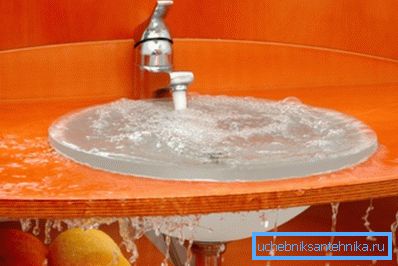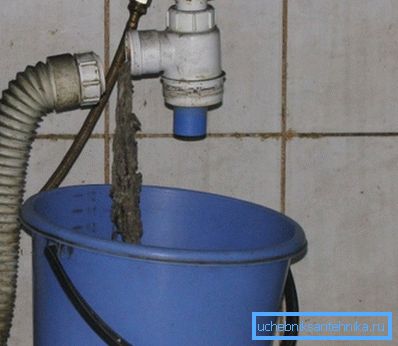How to clean the blockages in the pipes: causes and 3 ways
Sooner or later, every homeowner has to deal with the disruption of the normal operation of the internal sewage system, which is manifested in a significant reduction in its capacity. The most common cause of this phenomenon is the usual blockage, which significantly narrows, and in some cases completely clogs the internal lumen of sewer pipes. In such cases, many residents do not always understand what to clean - if sewage pipes are clogged.

Self cleaning sewage
In order for all owners of their own apartments to know how to clean the clogging in the pipe on their own, without resorting to professional plumber, this article will discuss several ways to do this simple work with the help of the simplest household plumbing tools.
Also, the reader will be offered detailed instructions, which provides a step-by-step description of all technological steps to eliminate blockages.

Causes of blockages
First of all, in order to correctly determine how to clean the pipes from clogging, you need to understand the reason why it could arise.
In most cases, the influence of the following factors can lead to violations of the household sewage system:
- Accidental or intentional discharge into the sewage system of solid household waste, coarse garbage, rags or solid food residues. The consequences of such a blockage appear almost immediately after flushing, because in most cases it leads to a complete blockage of the internal lumen of the tube. To eliminate it, only mechanical cleaning methods are used.

- The accumulation of grease, hair threads and other small debris, as well as the deposition of fecal sludge and limescale on the walls of sewage pipes eventually leads to a narrowing of the internal lumen. Depending on the intensity of use of the sewage system, this process can take several years. Light minor deposits can be eliminated by chemical means, and in advanced cases, mechanical intervention is required.
- Local clogging of the siphon of any plumbing fixture (bath, sink, toilet, shower) due to accumulation of small debris, hair, accidental hitting of small objects, etc. Can be eliminated both chemically and mechanically, as well as by disassembling and cleaning the siphon .

Tip! If there is a non-return valve in the sewage system, before clearing the pipes from clogging it is necessary to check if the incorrect operation is not the cause of the violation of the drain.
Plumbing plunger
A plunger is the simplest household sanitary fixture that is found in almost every home.
Its use is effective for eliminating local minor blockages caused by the accumulation of garbage in siphons, maintenance-free hydraulic locks, as well as in horizontal sections of pipes and drainage collectors.
- For example, if the pipe in the kitchen is blocked, you need to close the stopper and type a small amount of water into the sink so that its surface is several centimeters above the level of the drain hole.
- Remove the stopper and press the plunger's rubber cup to the inner surface of the sink at the center of the drain hole.
- Run a few short, but at the same time, sharp reciprocating movements, without tearing the bowl of the plunger from the bottom of the sink.
- Remove the plunger from the drain hole with a short, sharp movement, then flush the sewer system with plenty of hot water.
Tip! To soften fat deposits before using a plunger, it is recommended to pour a small amount of very hot water into the drain hole.
Chemical cleaners
The most common cause of blockages in the kitchen is the accumulation of food residues, grease, hair and other organic debris and biological waste in sewer pipes and water traps. For effective splitting and removal of organic substances, there are special chemicals based on caustic alkali.
Their advantage lies in the fact that before cleaning the sewage system, it is not necessary to disassemble the sink drain, and in addition the liquid tool even reaches the most remote and hidden places where no mechanical tool can reach. In addition, the low price of this tool allows you to use it regularly for preventive purposes.
Before you clean the clog in the pipe in the kitchen you need to carefully read the instructions, but in general the use of most liquid chemicals means the following:
- Shake the contents of the vial thoroughly and pour 200-250 ml of liquid into the sink drain hole, avoiding contact with furniture and open areas of the body.
- Leave the sink alone for 1.5-2 hours.
- After this time, flush the entire sewer system with plenty of hot or cold water.

Tip! The process of splitting biological residues in the sewage system may be accompanied by the release of an unpleasant odor, therefore, before cleaning the pipe from clogging, it is necessary to ensure the room is ventilated.
Plumbing cable
The most radical household tool to combat blockages of sewage is a flexible plumbing cable. Its use with its own hands allows you to eliminate even the complete blockage of sewage pipes by large foreign objects.
This device is an elastic, but at the same time, a rigid twisted cable, which on one side has a rotating handle, and on the other - a removable or stationary attachment in the form of a brush or hook.
- Before you clean the blockage in the pipe with a cable, you must turn off the water supply of all plumbing devices to prevent water from entering the sewer.
- After approximately determining the location of the blockage, disconnect the nearest plumbing appliances from the two sides from the intended clogged area from the sewage system.
- On the one hand, insert a sanitary cable into the pipe and gradually move it forward, while rotating the handle on the back side.
- Feeling when the tip of the cable rests on the likely accumulation of debris, try to push it forward and push it out on the other side of the pipe.
- If you can’t push it forward, you can try to wind the garbage on a brush or hook it with a hook located on the end of the cable, and then pull it towards you.

Tip! If the pipe is clogged in the bathroom or in the kitchen, first of all you need to make sure that the drain siphon is not clogged, and only then proceed to clean the entire system.
Conclusion
After reading this article, it becomes clear that any person, even without any practical skills in the field of plumbing, will be able to successfully cope with the cleaning of home sewage systems.
For more information on the subject of interest, you can watch the video in this article or read similar materials on our website.